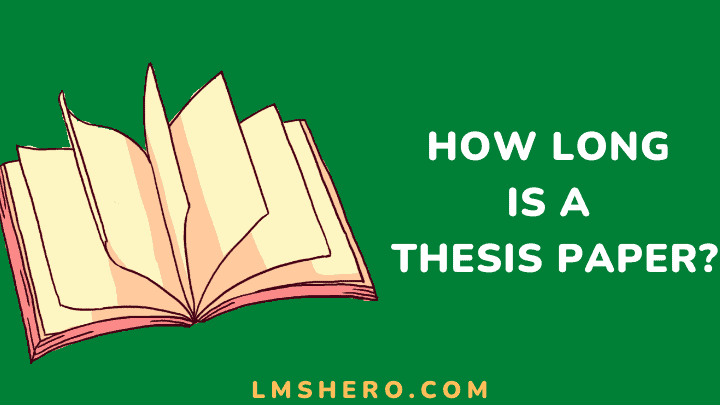So you’re wondering “how long is a thesis paper?” The question has been tossed around by graduate students for as long as there have been graduate students.
There are many opinions on how long a thesis paper should be, but there is no right or wrong answer.
The length of your paper will depend on the complexity of the topic, the level of detail you include, and the overall length of your scholarly work.
In this article, you will discover the ideal length of a thesis paper and how to format it appropriately.
Read on.
What is a thesis paper?
A thesis paper is a document you write as part of your academic degree program. It is your main argument for why you believe what you believe about a particular topic.
It’s an exploration of a topic undertaken to discover new knowledge. It’s the result of a process of intellectual growth, and it should be examined thoughtfully and critically.
A good thesis shows that you have explored the topic deeply and have come to some conclusions about it.
How long is a thesis paper?
It’s hard to put a number on how long a thesis paper should be because that depends on the individual writer, supervisor, the topic of the paper, and the types of data analysis and presentation.
However, a master’s thesis is generally between 50 – 80 pages and about 20,000 words, excluding the preliminary pages.
Note that no matter how long, one thing’s for sure: it’s worth your time and effort. Your thesis will not only reflect your intellectual prowess but also your dedication to your field of study.
So, commit to producing a high-quality thesis, and I guarantee you won’t regret it.
Factors that may determine the length of a thesis paper
When you decide to write a thesis, you choose to embark on a deep and personal exploration of a complex topic.
Many factors can influence your paper’s length – some of which are out of your control. They include but are not limited to:
- The quality and complexity of the thesis paper
- The extent to which the paper adheres to academic standards
- Clarity and conciseness of the writing
- Organization of the information
- Use of statistics and research methods
- The use of effective graphs, tables, and images (data presentation)
- The number of citations used in the paper will also affect the length
Although many factors can influence the length of a thesis paper, you will likely have the most success if you focus on four basic principles.
First, be aware of the types and research required for your topic. Furthermore, include enough detail to provide readers with a clear understanding of your argument.
In addition, pay attention to the format and structure of your paper. Fourth, make sure all your sources are properly cited and referenced.
Tips to properly format your thesis

1. Make the thesis title clear, concise, and easily understandable
When writing a thesis, it’s essential to make the title clear, concise, and easily understandable.
Too often, students cram too many ideas into a relatively brief title, making the paper difficult to read and understand.
When crafting your thesis title, it’s essential to make it clear, concise, and easily understandable.
This will help the reader see the main points of your paper quickly and easily and help them better understand the focus of your work. Having a title of about 24 words is best. You should also use an active voice.
2. Pay attention to fonts, margins, and space consistency
Thesis papers can often look very unprofessional if not formatted correctly. For example, fonts and margins may be set too large or small, making the paper look sloppy and unattractive.
Page numbers are also significant. In addition, space consistency is vital. Ensure all paragraphs, sections, and subsections are set at the same distance from the edge of the page.
There should be enough room left on each page for your text to flow without distractions. Once all these formatting details are taken care of, you can focus on the content. Here’s a quick guide:
- Fonts size must be 10 or 12 points in size. The font type should be Times New Roman, Arial, or Calibri depending on what your faculty or college approves.
- If you use superscripts and subscripts (e.g., formulas, footnotes, or endnote numbers), ensure that they don’t exceed two points smaller than the body font size
- Margins should be 1.5 inches on the left, and 1 inch each on the top, bottom, and right
- Paragraphs for chapters should be double-spaced, with the first line indented 0.5 inches.
Attention to these small details can make a big difference in how your thesis looks and feels.
3. Divide sections with headings appropriately
A thesis paper is not just some random document. It requires careful formatting to look professional and to be easy to read.
One of the most critical aspects of thesis formatting is correctly splitting sections into headings. Doing this ensures that each section is easily identifiable and that the entire document flows seamlessly.
A thesis formatted correctly will also be easier to edit and proofread, making your writing process much easier.
4. Organize your analysis with data presentation aids
A data presentation aid is anything that helps you organize and present your data in a clear, concise, and effective manner.
When you use a data presentation aid, you can increase the clarity and effectiveness of your arguments. The most common data presentation aids are graphs, tables, maps, and charts.
Graphs help illustrate trends or relationships between variables. Tables can be used to show the distribution or composition of data.
Charts can help you communicate visually complex data patterns. Maps provide an excellent way to describe Spatio-temporal relationships.
The best way to find the right data presentation aid for your thesis paper is to experiment with different techniques.
5. Understand how to format your preliminary pages
A preliminary page is one of the first pages in your thesis paper. It includes dedication, approval, table of contents, list of tables and figures, and your abstract.
The goal of a preliminary page is to pique the reader’s interest and leave them eager to read further.
You don’t need to include every detail on this page – just enough to intrigue their curiosity. When writing a preliminary page, be sure to keep these three principles in mind:
- Keep it concise
- Use clear, concise language
- Don’t waste time on fluff
By following these guidelines, you’ll ensure that your thesis is well-organized and error-free.
6. Citations and references are important
Citations and references are an essential part of formatting a thesis paper. Without them, your paper will not be acceptable to most journals.
A good rule of thumb is to include at least one citation per paragraph. Sometimes, you may need more than one citation in a paragraph.
Ensure you cite the source accurately. Detailed instructions are provided on formatting references and citations in APA style.
The references within each entry must be single-spaced, and the references should be separated by one double-spaced line. You should also continue to number your references throughout the section.
7. Check for grammatical errors and plagiarism
While it is important to have a well-written thesis, it is equally important to ensure the formatting and grammar are correct.
By checking for these errors, you can eliminate any potential sources of confusion or conflict with your readers.
Not only will this help ensure that your thesis is easy to read and understand, but it may also help avoid plagiarism penalties. You can compare Grammarly and Turnitin plagiarism tools to make an informed decision.
FAQs
What is the purpose of a thesis paper?
A thesis paper is a document that provides evidence for the author’s central argument in a scholarly work. It can guide future learning and help students defend their academic work.
How hard is writing a thesis?
It can be stressful, but with the right tools, patience and dedication, you’ll be able to write an outstanding thesis in no time.
How long does it take to write a full thesis?
Generally, master’s thesis writing takes 9 – 15 months if students follow the standard steps. This duration may be short or long depending on your school and dedication
Final thoughts
While the length of a thesis paper may vary from student to student, the sections above should provide an approximate length for most submissions.
Longer papers will likely require more explanations and examples; shorter papers may require less detail. All papers, no matter their length, should be thoroughly organized and well-researched.
Finally, include a detailed abstract and reference at the end of your work to show you have done your research and to avoid plagiarism.
An important aspect of writing a thesis is the thesis statement. It simply states the main idea (s) of the thesis. For more information, read the article on a thesis statement. You will learn about its types, purpose, and where the thesis statement is located.
Thanks for reading.






